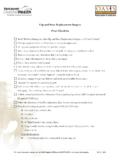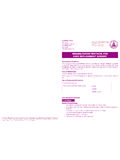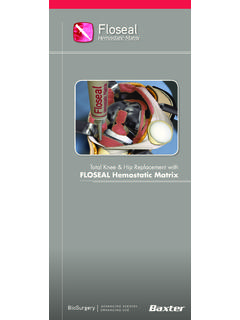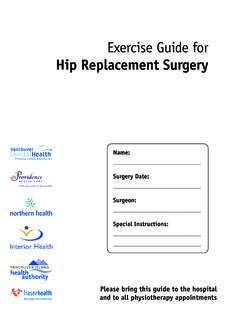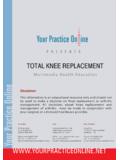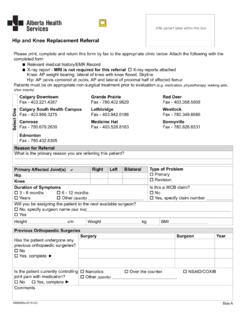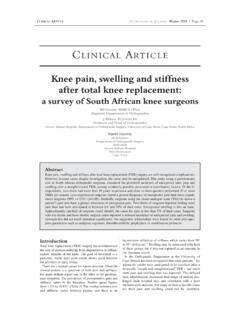Transcription of Post Operative Total Knee Replacement Protocol
1 The intent of this Protocol is to provide guidelines for progression of rehabilitation. It is not intended to serve as a substitute for clinical decision making. Progression through each phase of rehabilitation is based on clinical criteria and time frames as appropriate. These guidelines should be administered under the supervision of a physical therapist. post Operative Total knee Replacement Protocol Brian White, Terms and Definitions: ROM Range of Motion This defines the amount of mobility in your knee PROM Passive Range of Motion Mobility exercises remain completely passive without the use of muscles to move your knee AAROM Acitve Assisted (or partner assisted) ROM Range of motion with the assistance of a partner or your other leg and minimal use of the muscles of the surgical leg.
2 AROM - Active Range of Motion Range of motion using the muscles of the surgical leg POSTD post - Operative Day NWB Non Weight Bearing This means that you should keep all weight off of your leg. TTWB Toe Touch Weight Bearing This means that you may place a small amount of weight on your leg for balance purposes. PWB Partial Weight Bearing This means that you may place some weight on your leg. The amount may be defined by your doctor WBAT Weight Bearing as Tolerated This means that you may place weight on your leg, but to your tolerance. If your leg can not accept your full weight, crutches are advised. DVT Deep Vein Thrombosis This is a blood clot that can form in a deep vein. Proprioception This is a term to describe joint sense or your ability to feel how bent or extended your knee is without looking at it. Neuromuscular re-education This is the term used to train your muscles to fire in patterns that mimic function, such as balancing while standing.
3 Open Chain Exercise An exercise position in which your leg can be moved about you, such as kicking. Your foot is not on the ground or a platform for these types of exercises Closed Chain Exercise An exercise position in which your foot is on the ground or a platform, such as a squat or leg press. This Protocol was provided by Howard Head Sport Medicine Centers (303) 295-1403 Prehab (Presurgical Phase) Goals: Reduce Swelling Achieve optimal ROM in preparation for surgery Straight Leg Raise without lag Reduce load on knee to achieve optimal condition for surgery Exercise Regimen Use the following exercise regimens from Phase 1 in order to prepare the knee for surgery o Pain and Swelling o ROM - manual therapy has been shown to significantly improve ROM in knees with osteoarthritis o Strength o Teach post -op Protocol Exercises Phase 1 - Protection Phase ( post -op weeks 1-7) Goals.
4 Reduce swelling and pain Restore mobility Restore Full Extension in 2 weeks Gain 90 Flexion in 1 week Gain 120 Flexion in 3 weeks Full possible knee mobility in 6 weeks Restore patellar mobility Restore normal gait within limits set by surgeon Restore Active extension and normal quad recruitment Promote normal proprioceptive and neuromuscular control Pain and Swelling PRICE Protection, Rest, Ice, Compression, Elevation Use these items together to reduce pain and swelling At minimum, 5-6 times per day for 20-30 minute sessions There is no maximum! Wall Slides Modalities as indicated - Ultrasound, Electric Stimulation, Iontophoreses Ankle Pumps for swelling and DVT prevention This Protocol was provided by Howard Head Sport Medicine Centers (303) 295-1403 Range of Motion Passive Range of Motion o Wall Slides o Seated Passive flexion-extension o Table slides o Low Load Prolonged Stretches Coffee table hang for extension Seated prolonged flexion hold o CPM a constant passive motion machine (CPM) may be prescribed for 6-8 weeks and should be used 4-6 hours per day.
5 Active Assist Rang of Motion o Stationary Bike without resistance (begin post -op week 3) Patellar Mobilizations Manual therapy as indicated Quad and Hamstring Stretching as indicated Hydrotherapy o Aquajogging and ROM exercises are permitted when incisions have healed (~2weeks) Gait (walking) WBAT is typically prescribed after surgery though an assistive device (walker or crutches) will be necessary. Weaning from crutches or walker (begin when cleared to weight-bear): o Begin with weight shifting exercises o Begin walking with more weight on leg using crutches or walker o Single crutch or cane walking This will reduce weight on your surgical leg by 25% Be sure to place the crutch under the opposite arm o Walk small distanced in home without crutches and take crutches with you for longer distances Hydrotherapy water walking (permitted when incisions are healed) o Walk in water at shoulder level o Advance to walking at waist level Strength Quadriceps (Quads) o Quad Sets isometric quad contractions NMES (Neuromuscular Electric Stimulation) as indicated Biofeedback as indicated o Straight Leg Raising (SLR)
6 Hamstring Sets Isometric Hamstring contractions Calf Muscles Heel-Toe Raises Open-Chain hip exercises o Abduction o Adduction This Protocol was provided by Howard Head Sport Medicine Centers (303) 295-1403 Proprioception and Neuromuscular Re-education Begin open chain proprioception exercises Light co-contraction exercises Phase 2 Initial Strengthening - ( post - Operative weeks 5-10) Criteria to advancement to Phase 2 Minimal Swelling Full passive extension Full active extension Full passive flexion Lower extremity strength to allow for standing and walking short distances with minimal deviations without crutches Goals Eliminate Swelling Full active and passive ROM Increase leg strength to allow for: o Normal gait o Walking long distances o Stair ascending/descending o Double knee bends to 90 without compensations Swelling Continue PRICE ing with residual Modalities as indicated - Ultrasound, Electric Stimulation, Iontophoreses Avoid excessive strengthening and walking with moderate, residual swelling Range of Motion Patellar mobilizations and manual therapy as indicated Quad and Hamstring stretching as indicated Low Load Prolonged Stretches o Coffee table hang for extension o Seated prolonged flexion hold Strength Closed Chain Strength progression (Glutes and Quads) o Leg press with light weight and high repetitions o Mini Squats, 1/3 knee bends o Double knee bends to 90 o Light plyometrics on shuttle (if tolerated)
7 This Protocol was provided by Howard Head Sport Medicine Centers (303) 295-1403 Hamstring Specific Exercises o Carpet Drags o Hamstring Curls o Physio-ball bridging knee bends Calf Muscles Hip exercises o Side Steps with thera-band o Adduction Cardio o Begin stationary bike with resistance o Eliptical trainer o Treadmill walking with incline o Swimming (breast stroke is not recommended) Proprioception, Balance and Neuromuscular Re-education Begin double leg stability exercises on balance board Single leg balance on stable/semi unstable (foam) surface Single leg balance on balance board Variations of balance exercises with perturbation training Variations of balance exercises during alternate activity ( ball tossing) Phase 3 Advanced Strengthening ( post - Operative weeks 10- sport test completion) Criteria for advancement to Phase 3 No residual swelling present Full Active and Passive ROM Ascending and Descending stairs with involved leg without pain or compensation At least 1 minute of double knee bends without compensations Persons who do not participate in higher level activities may not need to advance to phase 3.
8 Activities that require advanced strengthening include: running, bounding sports, cutting sports and jumping sports, such as, skiing and snowboarding, golf, basketball, tennis and racquetball, soccer, football and hockey. Goals: Restore multi-directional strength and agility Restore ability to absorb impact on leg (plyometric strength) Pass sport test Strength, Agility, Balance and Stability Training Increase time on double knee bends with resistance This Protocol was provided by Howard Head Sport Medicine Centers (303) 295-1403 Increase time on single knee bends. Add resistance as tolerated Forward backward jog exercises with sport cord Lateral Agility exercise Advanced perturbation, balance and stability exercises Continue with cardio training Phase 4 Return to Sport (passing of sport test 6 months) Criterion for advancement to phase 4 Pass modified/adjusted sport test Strength and Agility Light Agility Drills o Chop-Downs o Back Pedals o W-Cuts o Z-Cuts o Cariocas o Cutting Drills o Sport Specific Drills Adjust Strength and Cardio Regimen to demands of sport Begin following sports at specified times or according to the discretion of surgeon and/or physical therapist oMountain biking 4-5 months oGolf 5 months oDoubles tennis 6 months oSkiing and snowboarding (if you know how)
9 6 months This Protocol was provided by Howard Head Sport Medicine Centers (303) 295-1403

